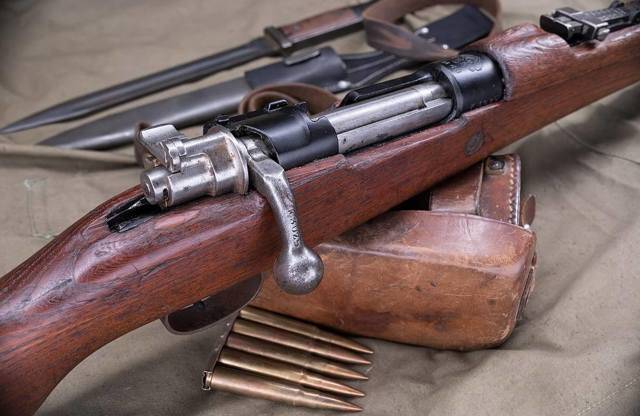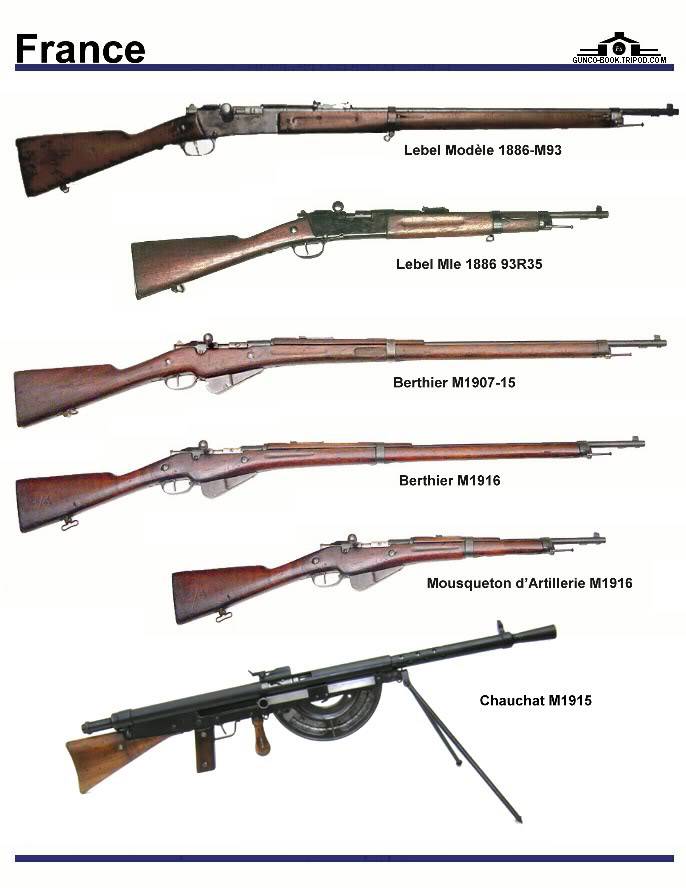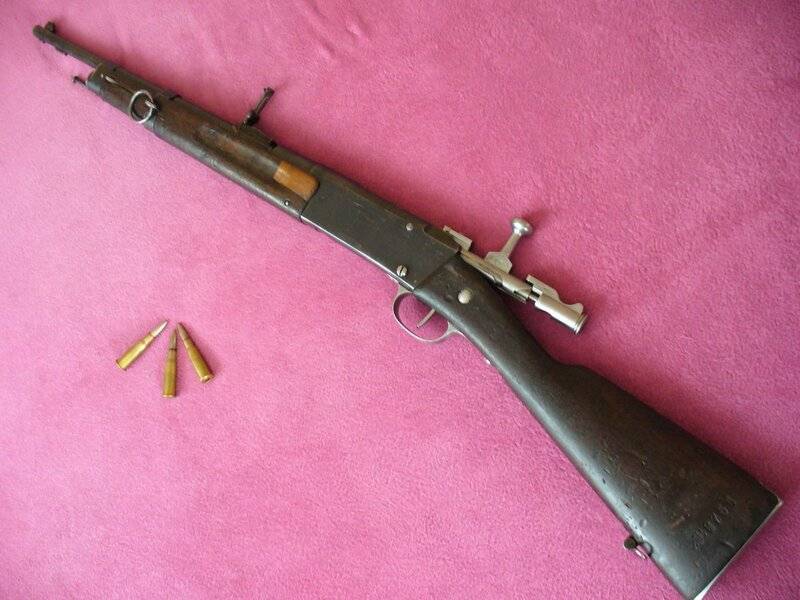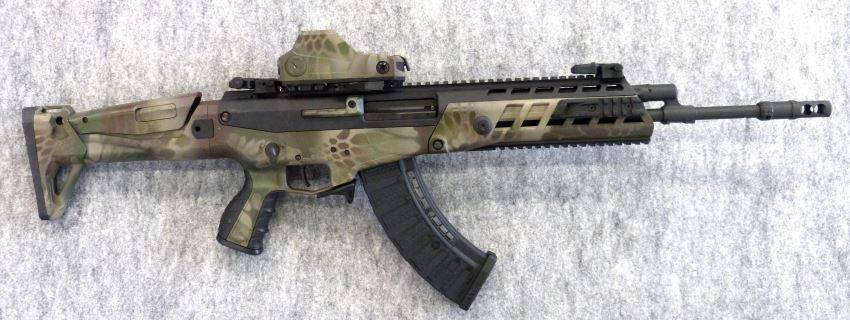Происхождение и развитие
Исторически, винтовка Lebel Mle 1886 года была первым военным огнестрельным оружием, которое будет использовать бездымные порошковые боеприпасы. Этот новый порох, сделанный из устойчивой нитроцеллюлозы, назвал «Poudre B» («Порошок B») и просто изобрел в 1884 Пол Виейлл (1854-1934). «Poudre B» был в три раза более сильным, чем дымный порох, для того же самого веса, и не оставил фактически остатков сгорания. В приблизительно то же самое время, в 1882, капитан (позже полковник) Эдуард Рубин (1846–1920) (швейцарская армия) изобрел первые пули винтовки Цельнометаллической оболочки (FMJ). Обертывание защитного медного жакета вокруг свинцового сердечника пули было также поддающимся трансформации событием в истории огнестрельного оружия: с этого времени пули могли быть выпущены в очень высокие скорости, не тая в стволе винтовки. Эдуард Рубин скоро сопровождался Hebler, также в Швейцарии, кто успешно создал покрытые кожухом пули винтовки первой стали.
Вскоре после того, в январе 1886, французский военный Министр, генерал Булэнджер, просил срочное применение этих двух технических прорывов к дизайну новой винтовки пехоты. Он назначил генерала Трэмонда отвечающим за проект, который должен был быть закончен в течение одного года. Во-первых 11 мм гильза Граса были перепроектированы в 8-миллиметровый случай, преобразование, выполненное полковником Грасом и лейтенантом-полковником Дезэлеуксом. Повторяющийся механизм, полученный из французской магазинной винтовки Gras-Kropatschek 1884 года Mle, был осуществлен Альбертом Клозом и Луи Вердином в арсенале Шательро. Две противоположной передней тяги захвата болта, вдохновленная двумя тягой захвата задней части на болте более ранней швейцарской винтовки Vetterli, была разработана полковником Бонне. 8-миллиметровая квартира рылась, Цельнометаллическая оболочка «Balle M» пуля была предложена генералом Трэмондом и разработана лейтенантом полковником Николасом Лебелем, в честь которого винтовка (и калибр) названы. Однако, лейтенант-полковник Лебель не возглавлял команду, ответственную за создание новой винтовки. Он дружески возразил во время своей целой жизни, что генерал Трэмонд и полковник Грас были двумя вышестоящими должностными лицами, которые совместно заслужили того кредита. Тем не менее, его имя, которое только определяло «Balle M» пуля как «Балл Лебель», неофициально придерживалось всего оружия.
Lebel следовал за Mle 1874 Gras 11 мм действия болта и французами Mle 1878 Военно-морская винтовка Кропачека, разработанная австрийцем, Альфредом фон Кропачеком, и разделил трубчатый журнал последнего в переднем конце. Две переходных винтовки действия болта пехоты повторения, все еще разделенные на камеры для 11-миллиметрового патрона черного пороха Gras, следовали за винтовкой Mle 1878 года: Mle 1884 и Mle 1 885 винтовок. Последний имел запас костюма-двойки и крупный стальной приемник и близко напоминает Mle 1886 Lebel.
В 1893 улучшенная версия M1886 Lebel определялась Фузея Mle 1 886 М (modifié) 93. Самое полезное улучшение было модификацией головки болта, таким образом, это отклонит далеко от лица стрелка любые горячие газы, сбегающие из разорванной гильзы. Булавка увольнения и ее задняя кнопка были уже изменены в 1887, в то время как прут укладки остался неизменным. Наконец, фиксация заднего вида на баррель была существенно улучшена во время той модификации 1893 года. (См.: Ломбард Клода, 1987)
Винтовка Lebel была произведена тремя правительственными арсеналами: Châtellerault, Св.-Etienne и Тюль. Это показало запас костюма-двойки и крупный приемник, разработанный, чтобы противостоять более высоким давлениям, развитым новыми бездымными основанными на порошке патронами. Между 1935 и 1940, длина карабина (17,7-дюймовый баррель) версия Lebel была выпущена установленным колониальным войскам в Северной Африке. Эта короткая версия карабина Lebel, названного Mle 1886 M93-R35, была собрана в больших количествах (приблизительно 50 000) в Manufacture d’Armes de Tulle (ЦИНОВКА), начавшись в 1935. Это использовало все части Лебеля за исключением недавно произведенного более короткого барреля длины карабина. Так как ламповый магазин нового карабина должен был быть сокращен также, его способность журнала была только тремя раундами.
lebel 1886 .
| 1886 Lebel Rifle: The Gun That Changed The World |
 Нажми для просмотра Нажми для просмотра | The legendary French
Lebel rifle was a
revolution in small
arms design: It
introduced smokeless
powder, which gave
the rifle … | | | | | | | | | | | | | Тэги: |
|
| |
 Нажми для просмотра Нажми для просмотра | Link to part 2:
Shooting my French
1886 Lebel Rifle
made in 1887. | | | | | | | | | | | | | Тэги: |
|
| |
| Снайперская винтовка LEBEL 1886 | BATTLEFIELD 1 “Они не пройдут” |
 Нажми для просмотра Нажми для просмотра | Обзор
снайперско
й винтовки
Lebel Model 1886.
▻Поддержа
ь Зомбика
и его
канал: … | | | | | | | | | | | | | Тэги: |
|
| |
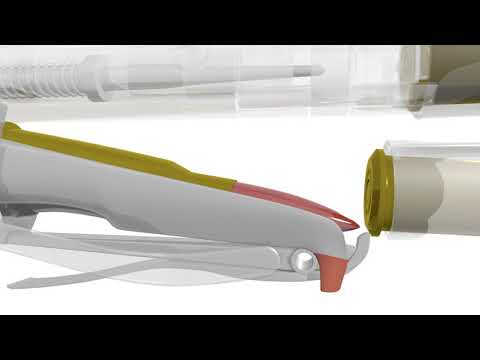 Нажми для просмотра Нажми для просмотра | The rifle that made
so many designs
obsolete seemingly
overnight. Actually
I would say it was
the powder that did
that, this
design … | | | | | | | | | | | | | Тэги: |
|
| |
| M1886 Lebel Rifle at the Range |
 Нажми для просмотра Нажми для просмотра | The French M1886
Lebel was the first
smallbore smokeless
powder rifle adopted
by a major military,
and was a game
changer in … | | | | | | | | | | | | | Тэги: |
|
| |
| Battlefield 1: Lebel 1886 animations |
 Нажми для просмотра Нажми для просмотра | I switch between
standard rounds to k
bullets. K bullets
tend to get the
animation where the
user would
forcefully pull the
bolt. | | | | | | | | | | | | | Тэги: |
|
| |
| The First Modern Military Rifle: The Modele 1886 Lebel |
 Нажми для просмотра Нажми для просмотра | Get the shirt here:
… | | | | | | | | | | | | | Тэги: |
|
| |
| Мартини-Генри vs Lebel 1886 Battlefield 1 |
 Нажми для просмотра Нажми для просмотра | В этом
видео я
расскажу о
затворных
винтовках
Мартини-Ге
ри и Lebel 1886
из Battlefield
1.Моя
группа VK: … | | | | | | | | | | | | | Тэги: |
|
| |
| Hunt : Showdown – The Lebel Rifle |
 Нажми для просмотра Нажми для просмотра | Finally a new bolt
action rifle in the
game! Had some fun
using this thing
today. Excited for
all the content
coming with 6.0. | | | | | | | | | | | | | Тэги: |
|
| |
| Saint-Etienne – Lebel Mle 1886 M93 R35 – 8x50mmR Lebel – Part 1 |
 Нажми для просмотра Нажми для просмотра | Many apologies for
the blurriness. See
part 2 here:
Shooting my new
(old) French Lebel
R35 … | | | | | | | | | | | | | Тэги: |
|
| |
| St. Etienne – Lebel Mle 1886 M93 R35 – 8x50mmR Lebel – Part 2 |
 Нажми для просмотра Нажми для просмотра | Revisiting some old
guns. Shooting my
old R35 Lebel;
hopefully got a
better video of it. | | | | | | | | | | | | | Тэги: |
|
| |
| Lebel modèle 1886 ВИНТОВКА ЛЕБЕЛЯ первая винтовка на бездымном порохе |
 Нажми для просмотра Нажми для просмотра | Винтовку
Лебеля все
знают как
первую
винтовку с
патронами
на
бездымном
порохе, с
оболочечно
е пулей и
уменьш… | | | | | | | | | | | | | Тэги: |
|
| |
| French Lebel Model 1886/93 Rifle. 8x50R Lebel. |
 Нажми для просмотра Нажми для просмотра | Please check out my
Patreon! Main
battle rifle of
France during WW1
and WW2. | | | | | | | | | | | | | Тэги: |
|
| |
| Présentation de nos fusil Lebel mod 1886 |
 Нажми для просмотра Нажми для просмотра | Bonjour ,
aujourd’hui nous
vous présentons nos
Lebel . Un grand
merci à vous , 128
abonnées , merci
encore … | | | | | | | | | | | | | Тэги: |
|
| |
| Lebel 1886 Run and Gun (This One Sucked) |
 Нажми для просмотра Нажми для просмотра | By popular demand,
we are now ponying
up and putting the
Lebel on the run and
gun course. As the
first rifle to make
use of … | | | | | | | | | | | | | Тэги: |
|
| |
| Loadout – French Standard Issue Lebel 1886 Infantry | Battlefield 1 Sniper Gameplay |
 Нажми для просмотра Нажми для просмотра | Hey guys, today
we’re going to
test out a French
themed setup,
configured around
what a typical
infantry man would
have … | | | | | | | | | | | | | Тэги: |
|
| |
| STRZELANIE Z “AFGANSKIEGO” LEBEL Mle1886/93 cal 8mm Lebel |
 Нажми для просмотра Нажми для просмотра | Strzelanie z
zagadkowego
afganskiego lebela | | | | | | | | | | | | | Тэги: |
|
| |
| Démontage complet Fusil Lebel 1886 M93 |
 Нажми для просмотра Нажми для просмотра | #arme #ww1Le Feu aux
Poudres – Démontage
complet du fusil
Lebel Mle1886 M93.
Il vous suffira
d’avoir 2
tournevis pour le
… | | | | | | | | | | | | | Тэги: |
|
| |
| ⊕ Fusil Lebel 1886 M93: Histoire & tir #1 |
 Нажми для просмотра Нажми для просмотра | histoire #arme #ww1
====================
EPISODE
TEST================
====== Le fusil
Lebel porte mal son
nom: en … | | | | | | | | | | | | | Тэги: |
|
| |
| Battlefield 1: Lebel Model 1886 Review (Weapon Guide) | BF1 New DLC Weapons | Lebel Gameplay |
Notes
- ^ , pp. 67–71&108–109
- , p. 26.
- , p. 27.
- , p. [page needed].
- Eric Dorn Brose (2004). The Kaiser’s Army: The Politics of Military Technology in Germany During the Machine Age, 1870-1918. Oxford University Press. pp. 47–50. ISBN 978-0-19-517945-3.
- , p. [page needed].
- ^ , p. 30.
- ^ , p. 31.
- ^ Thomas, Nigel; Babac, Dusan (25 Jul 2001). Armies in the Balkans 1914–18. Men-at-Arms 356. Osprey Publishing. pp. 12, 33. ISBN .
- ^ Pawly, Ronald; Lierneux, Pierre (10 Jun 2009). The Belgian Army in World War I. Men-at-Arms 452. Osprey Publishing. p. 42. ISBN .
- ^
- , p. 50.
- ^ Gander, Terry (2000). . The Crowood Press. p. . ISBN .
- Guido Rosignoli, “RSI”, Ermanno Albertelli Editore 1998, p. 27
- ^ W. Darrin Weaver (2005). Desperate Measures: The Last-Ditch Weapons of the Nazi Volkssturm. Collector Grade Publications. p. 60. ISBN .
- Windrow, Martin (15 Nov 1998). The French Indochina War 1946–54. Men-at-Arms 322. Osprey Publishing. p. 41. ISBN .
- ^
- Windrow, Martin (1997). The Algerian War, 1954-62. Men-at Arms 312. London: Osprey Publishing. pp. 18–19. ISBN 978-1-85532-658-3.
- McLachlan, Sean (20 Sep 2011). Armies of the Adowa Campaign 1896: The Italian Disaster in Ethiopia. Men-at-Arms 471. Osprey Publishing. pp. 35, 44. ISBN .
- Giletta, Jacques (2005). Les Gardes Personnelles des Princes de Monaco (1st ed.). Taurus Editions. ISBN 2 912976-04-9.
- de Quesada, Alejandro (20 Jan 2015). The Spanish Civil War 1936–39 (2): Republican Forces. Men-at-Arms 498. Osprey Publishing. p. 38. ISBN .
- Windrow, Martin (15 Nov 1998). The French Indochina War 1946–54. Men-at-Arms 322. Osprey Publishing. p. 41. ISBN .
Users
- Algeria
- Belgium
- Republic of China Used by Yunnan Clique forces
- Czechoslovakia
- Democratic Republic of Georgia
- Ethiopian Empire
- France
- German Empire
- Nazi Germany: issued to Volkssturm units.
- Kingdom of Greece
- Kingdom of Hejaz
- Kingdom of Italy
- Iraq: Iraqi insurgents
- Lebanon
- Monaco: Compagnie des Carabiniers du Prince
- Second Polish Republic
- Kingdom of Romania
- Russian Empire
- Kingdom of Serbia
- Somalia
- Soviet Union
- Second Spanish Republic
- Thailand
- United Kingdom : issued to Home Guard units after Dunkirk.[citation needed]
- United States: used during WWI
- Vietnam : used by Vietnamese National Army and Viet Minh/Viet Cong
References
- Lombard, Claude (1987). La Manufacture Nationale d’Armes de Châtellerault (1819–1968). 162 Grand Rue, Poitiers, 86000, France: Librairie Brissaud. ISBN 2-902170-55-6. This large illustrated volume (in French) contains the detailed technical history and production statistics for the Lebel rifle as well as detailed technical accounts on the Chassepot, Gras, Kropatschek and Berthier weapons and how they came to be designed and manufactured. This is regarded as the fundamental research volume on the subject. The author is a retired armament engineer who spent most of his career at Châtellerault and had full access to all the archives and the prototypes.
- Huon, Jean (1988). Military rifle and machine gun cartridges. Alexandria, Virginia: Ironside International Publishers. ISBN 0-935554-05-X. This volume (in English) provides a detailed description of all the types of 8mm Lebel ammunition, including Balle M, Balle D (a.m.) and Balle N. The 7x59mm Meunier cartridge (for the semi-automatic A6 Meunier rifle) is also illustrated and described in detail.
- Huon, Jean (1995). French autoloading rifles. 1898–1979 (Proud promise). Collector Grade Publications. ISBN 0-88935-186-4. This volume (in English) contains a highly detailed technical “Introduction” chapter describing the Lebel rifle and its ammunition. This volume primarily describes all French semi-automatic rifles since 1898, notably the Mle 1917 and Mle 1918 semi-automatic rifles, the Meunier (A6) rifle as well as the MAS 38-39 to MAS49 and 49/56 series.
- Schwing, Ned, ed. (2003). Standard Catalog of Military Firearms. Krause Publications. ISBN 0-87349-525-X. Contains an informative and detailed page dedicated to the Lebel rifle (by David Fortier).
- de Haas, Frank; Van Zwoll, Wayne (2003). Bolt Action Rifles. Krause Publications. ISBN 0-87349-660-4. An illustrated chapter in this volume reviews in depth the Lebel and Berthier rifles (and carbines).
- Malingue, Bruce (2006). “Fusil Lebel”. Le Tir Sportif au Fusil Reglementaire. Crepin-Leblond. pp. 332–334. ISBN 2-7030-0265-3. The author (in French) is justifiably critical of the Lebel’s sights.
- James, Gary (October 2014). “France’s Great War Masterpiece. The 1886/93 Lebel”. American Rifleman. Vol. 162 no. 10. National Rifle Association.
Operation, features, and accessories
In operation, the bolt is turned up to the vertical position until the two opposed front locking lugs are released from the receiver. At the end of the bolt’s opening phase, a ramp on the receiver bridge forces the bolt to the rear thus providing leveraged extraction of the fired case. The rifle is fitted with a two-piece wood stock, and features a spring-loaded tubular magazine in the fore-end. Taking aim at intermediate distances is done with a ramp sight graduated between 400 and 800 meters. The ladder rear sight is adjustable from 850 to 2,400 meters. Flipping forward that ladder sight reveals the commonly used fixed combat sight up to 400 meters. The Mle 1886 rifle has a 10-round capacity (eight in the under barrel tube magazine, one in the transporter, and one in the chamber). The Lebel rifle features a magazine cutoff on the right side of the receiver. When activated it prevents feeding cartridges from the magazine.
The Mle 1886 Lebel rifle was issued with a long needle-like quadrangular épée bayonet, the Épée-Baïonnette Modèle 1886, with a length of 52 cm. (20 in.). With its X-shaped cross section, the épée bayonet was optimized for thrusting, designed to readily penetrate thick clothing and leather. The bayonet was dubbed “Rosalie” by French soldiers who were issued it during World War I.
8mm Lebel cartridge
When it first appeared, the Lebel’s 8×50R smokeless ammunition allied to its longer range and flatter trajectory brought a revolution in infantry armament. A soldier equipped with a Lebel could outrange troops carrying rifles chambered for black-powder, large-caliber lead-bullet ammunition. Using smokeless powder, he could remain virtually invisible to an enemy at longer ranges, yet locate an enemy at any range by the smoke from their rifles. He could also carry more cartridges for the same overall weight.
A new 197 gr (12.8 g) solid brass (90% copper-10% zinc) pointed (spitzer) and boat-tail bullet (“Balle D“)—historically the very first boat-tailed plus spitzer rifle bullet to be invented and then widely manufactured—was adopted for the Lebel rifle in 1898 and placed in generalized service after 1901. Desaleux’s own Balle D provided a flatter trajectory and increased the range of the Mle 1886 rifle to about 4,000 yards and its maximum effective wounding distance (when fired indirectly at massed area targets) to 1,800 yards. More importantly, due to the bullet’s flatter trajectory, the realistic effective range of the 8mm Lebel was increased to approximately 457 yards (418 m) using open sights. The altered ballistic trajectory of the new cartridge necessitated a replacement of the Lebel’s rear sights.
Firstly, in order to avoid accidental percussion inside the Lebel tube magazine and in order to receive the pointed bullet tip of the cartridge that followed, all the French-manufactured military Balle D and Balle N ammunition had a circular groove etched around each primer pocket. Moreover, the Berdan primer on each French-made military Balle D round was further protected against accidental percussion by a thick, convex primer cover which was crimped in after 1915, the “Balle D a.m.”
The last type of Lebel military issue ammunition to be introduced was the Cartouche Mle 1932N, using a cupro-nickel, silver-colored, jacketed spitzer boat-tailed lead-cored bullet which was only suitable for Lebel and Berthier rifles marked “N” on top of the receiver and barrel. This 8mm Lebel heavier Balle “N” ammunition had originally been designed to increase the range of the Hotchkiss machine gun. Its manufacturing ceased in France during the late 1960s.
8mm Lebel ammunition was powerful for its time. It ranked slightly higher in muzzle energy than .303 British and slightly lower than the German 7.92×57mm Mauser cartridge. The chief negative characteristic of 8mm Lebel ammunition was the geometry of its rimmed bottlenecked case, due to the will to reuse 11mm Gras case set of tools. This adversely affected the magazine capacity and functioning of firearms, particularly in automatic weapons such as the Chauchat machine rifle. The Lebel cartridge’s heavily tapered case shape and substantial rim forced weapon designers to resort to magazines with extreme curvatures as for the Chauchat machine rifle. In contrast, rimless straight-wall cartridges such as the .30-06 Springfield and the 8×57mm Mauser could easily be loaded in straight vertical magazines.
Competitors and successors
Upon its introduction, the Lebel rifle proved to be vastly superior to the Mauser M-71/84, the German Army’s replacement of the Model 1869 Werder. France finished its rearmament program with the Lebel in 1889, just 18 months after Germany had completed its rifle replacement program with 780,000 M-71/84s. The new French rifle alarmed Bismarck. Tests at Spandau arsenal in the winter of 1887-1888 found that the Lebel could fire 43 rounds of smokeless powder ammunition per minute compared to just 26 of black-powder ammunition for the M-71/84. The inferiority of the Mauser M71/84 and its 11mm black-powder ammunition was one reason why Bismarck opposed going to war with France that winter, despite being pressed by War Minister Waldersee (another reason was that the new French De Bange field artillery, now equipped with breech loaders after the lessons of the 1870 war, both outnumbered and outperformed the Krupp C64 field guns in their rate of fire).
The Mle 1886 rifle proved to be a sturdy and serviceable weapon, but one which became rapidly outdated by advances in military rifle and ammunition designs. As early as 1888, the German Army’s Rifle Testing Commission had introduced in response a completely new turnbolt magazine rifle with a spring-loaded box magazine: the Gewehr 88 “commission” rifle. Above all else, it had been designed around the first ever rimless military cartridge using the new smokeless powder ammunition: the 7.92×57mm Mauser cartridge. The early Gewehr 88 was followed 10 years later by the highly successful Gewehr 98 Mauser rifle which still fired the same cartridge but with ballistic improvements.
In response to being left behind by Germany’s Mauser rifle, the French military decided in 1909 to replace the Lebel and its rimmed cartridge by more advanced designs. Consequently, while the bolt action Berthier rifle was first issued in 1907 as a stop-gap to arm colonial troops, the French defense ministry was planning to leapfrog other military forces with an advanced semi-automatic infantry rifle. This new weapon was the Meunier rifle, also known as the Fusil A6, which chambered a more powerful 7×59mm rimless cartridge. It was adopted in 1912 after an extensive competitive process. However, its manufacture, which was to begin in 1913, was suspended because of the imminent risk of war with Germany. Instead, and during World War I, the French Army chose the easier and less expensive solution of adopting a gas-operated semi-automatic rifle which incorporated some Lebel parts: the Fusil Mle 1917 RSC, once again in 8mm Lebel caliber. It was manufactured in large numbers (85,000) during 1918 and issued to select soldiers in infantry regiments. However, the Mle 1917 RSC was criticized by infantrymen as being too heavy, too long, and too difficult to maintain in the trenches. Furthermore, it also needed a special five-round clip to operate. In the end, the aged M1886 Lebel and variants of the Berthier rifle remained in service until the Armistice of November 11, 1918 and beyond.
Конкуренты и преемники
На его введение винтовка Lebel, оказалось, значительно превосходила Mauser M-71/84, замену немецкой армии ретранслятора однократного оружия иглы Dreyse. Франция закончила свою программу перевооружения с Lebel в 1889, всего спустя 18 месяцев после того, как Второй Рейх закончил свою программу замены винтовки с 780 000 M-71/84s. Новая французская винтовка встревожила Бисмарк. Тесты в Шпандау зимой 1887-1888 нашли, что Lebel мог пустить 43 очереди бездымных порошковых боеприпасов в минуту по сравнению со всего 26 из боеприпасов черного пороха для M-71/84. Неполноценность Mauser M71/84 и его 11-миллиметровых боеприпасов черного пороха была одной причиной, почему Бисмарк противостоял вступлению в войну Францией той зимой, несмотря на то, чтобы быть нажатым военным министром Волдерси (другая причина состояла в том, что новая артиллерия области French De Bange, теперь оборудованная погрузчиками зада после уроков войны 1870 года, оба превзойденные численностью и, выиграла у полевых орудий Krupp C64 в их скорострельности).
Винтовка 1886 года Mle, оказалось, была крепким и пригодным к эксплуатации оружием, но тот, который стал быстро устаревшим достижениями в военных проектах винтовки и боеприпасов. Уже в 1888 Комиссия по Тестированию Винтовки немецкой армии ввела в ответ абсолютно новую turnbolt винтовку журнала с пружинным коробчатым магазином: винтовка «Комиссии» Gewehr 88. Прежде всего остального это было разработано вокруг самого первого военного патрона без оправы, используя новые бездымные порошковые боеприпасы: 7.92×57mm патрон Маузера. Ранний Gewehr 88 сопровождался 10 лет спустя очень успешной винтовкой Gewehr 98 Mauser, которая все еще запустила тот же самый патрон, но с баллистическими улучшениями.
В ответ на то, чтобы быть оставленным позади винтовкой Маузера Германии французские вооруженные силы решили в 1909 заменить Lebel и его оправленный патрон более продвинутыми проектами. Следовательно, в то время как действие болта, винтовка Berthier была сначала выпущена в 1907 как временная замена, чтобы вооружить колониальные войска, французское министерство обороны, планировало опередить другие вооруженные силы с продвинутой полуавтоматической винтовкой пехоты. Это новое оружие было винтовкой Менье, также известной как Фузея A6‘, который разделенный на камеры более сильное 7×59mm патрон без оправы. Это было принято в 1912 после обширных конкурирующих процессов. Однако, его изготовление, которое должно было начаться в 1913, было приостановлено из-за неизбежного риска войны с Германией. Вместо этого и во время Первой мировой войны, французская армия выбрала более легкое и менее дорогое решение принятия управляемой газом полуавтоматической винтовки, которая включила некоторые части Lebel: фузея Mle 1917 RSC, еще раз в 8-миллиметровом калибре Lebel. Это было произведено в больших количествах (85,000) в течение 1918 и вышло, чтобы выбрать солдат в полках пехоты линии. Однако Mle 1917 RSC подвергся критике пехотинцами, как являющимися слишком тяжелым, слишком долго, и слишком трудный, чтобы поддержать в траншеях. Кроме того, этому также была нужна специальная скрепка с пятью раундами, чтобы работать. В конце, в возрасте M1886 Lebel и вариантов винтовки Berthier остался в обслуживании до Перемирия от 11 ноября 1918 и вне.

 Нажми для просмотра
Нажми для просмотра Нажми для просмотра
Нажми для просмотра Нажми для просмотра
Нажми для просмотра Нажми для просмотра
Нажми для просмотра Нажми для просмотра
Нажми для просмотра Нажми для просмотра
Нажми для просмотра Нажми для просмотра
Нажми для просмотра Нажми для просмотра
Нажми для просмотра Нажми для просмотра
Нажми для просмотра Нажми для просмотра
Нажми для просмотра Нажми для просмотра
Нажми для просмотра Нажми для просмотра
Нажми для просмотра Нажми для просмотра
Нажми для просмотра Нажми для просмотра
Нажми для просмотра Нажми для просмотра
Нажми для просмотра Нажми для просмотра
Нажми для просмотра Нажми для просмотра
Нажми для просмотра Нажми для просмотра
Нажми для просмотра Нажми для просмотра
Нажми для просмотра



